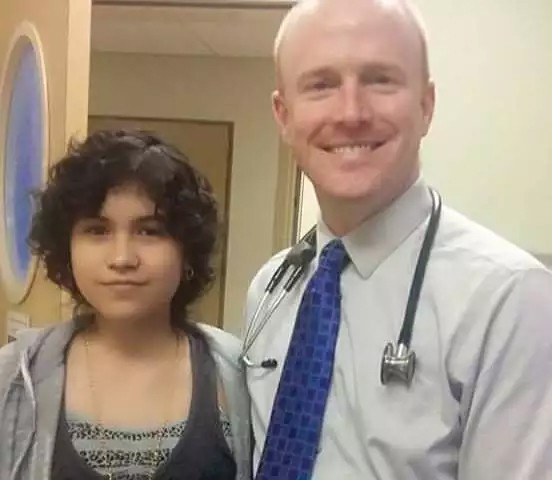
In 2016, the 13-year-old girl, Briana, was diagnosed with a rare tumor in the abdomen and wrapped around the abdominal aorta. Recurrence after tumor resection, no drug can be cured. There is TRK fusion in Briana's tumor cells. She participated in the first phase clinical trial of larotrectinib with significant efficacy. Now she has returned to school and is looking forward to the career of New York fashion designers.
Researchers at the Southwestern Simons Cancer Research Center at the University of Texas, USA, have announced that a new targeted drug for fusion genes (present in multiple cancers) is effective in 93% of pediatric patients.
Most anticancer drugs target specific organs or parts. Larotrectinib is the first anticancer drug designed to meet the FDA's breakthrough treatment design, targeting patients with specific fusions of two genes in tumor cells, regardless of the type of tumor they are suffering from. The study was published in The Lancet Oncology.
The study's lead author, Dr. Ted Laetsch, assistant professor of pediatrics at the Harold C. Simmons Comprehensive Cancer Center, said, "In some cancers, part of the TRK gene is attached to another gene. This is called fusion. Once this happens, the originally turned off TRK gene is turned on, causing the cells to grow wildly. The drug is unique in its high selectivity and blocks the TRK receptor."
Larotrectinib is a targeted drug for TRK fusion. TRK fusion occurs in many types of cancer. Although only a small percentage of adult cancers have TRK fusion, they are common in some rare pediatric cancers, such as pediatric fibrosarcoma, congenital mesoderm nephroma, papillary thyroid cancer, Dr. Laetsch said. He is the head of the Experimental Treatment Program (ETP) at the Pauline Allen Gill Cancer and Blood Disease Center in Dallas.
"In this study, every patient with TRK fusion-positive solid tumors treated, the tumors were reduced. Larotrectinib reflects an almost universal treatment effect, which is unprecedented," Dr. Laetsch said.
These include Briana Ayala, a 13-year-old girl from El Paso, Texas. Her dream is to engage in fashion design. In 2016, Briana was found to have a rare tumor in the abdomen and wrapped the abdominal aorta.
Elbasso's surgeon thought the operation was too dangerous, so Briana's family took her to the Children's Health Center in Dallas. There, Dr. Stephen Megison, a professor of surgery at the University of Texas Southwestern Medical Center, removed most of the tumors, but also removed some of the aorta.
However, the cancer cells began to grow again and they were unable to operate.
Dr. Laetsch performed a genetic test on the tumor of Briana and found that there is TRK fusion in cancer cells, which means that new drugs may be useful.
Briana participated in a phase 1 clinical trial of larotrectinib, taking it twice a day. Within a few weeks, abdominal pain and swelling subsided, and the scan showed a marked atrophy of the tumor.
Nearly two years later, Briana returned to school and was able to chase and play with her dog, "Goofy" and seven long-tailed parrots. In addition, she also picked up the sketchbook painting. Today she is looking forward to the career of New York fashion designers.
“These are the amazing reactions of larotrectinib,†Dr. Laetsch said. “It really makes me happy.â€
Last month, the New England Journal of Medicine published a trial of larotrectinib in adult patients – 75% effective.
TRK-fusion mutations can be found in many types of cancer, including lung, colon, thyroid, and breast cancer, as well as certain pediatric tumors. TRK is an abbreviation for myogenin receptor kinase, a gene that plays a key role in the development of the brain and nervous system, but has limited effects on the regulation of these nervous system functions such as pain.
Larotrectinib is a kinase inhibitor molecule that acts by reducing the enzymatic activity of key cellular responses. The high selectivity of the drug means that it does not cause serious side effects such as those caused by traditional cancer treatment, and indeed no patient with TRK fusion has withdrawn from the study due to drug side effects.
Moreover, for most patients, this response continues to be effective. “In some of the past targeted drugs, many patients initially responded well, but then failed due to the rapid increase in drug resistance. So far, most patients seem to be consistently effective in responding to Larotrectinib,†Dr. Laetsch He said that he is now doing research at the Department of Hematology and Oncology in the Southwestern Department of Pediatrics at the University of Texas, in the direction of "using tumor molecular analysis to guide treatment."
The next step in the study was to conduct clinical trials in which drug-resistant patients were treated with similar drugs. Dr. Laetsch will be the national head of clinical trials for children.
Electronics Industrial Nitrile Gloves
Electronics Industrial Nitrile Gloves,Pure Nitrile Exam Gloves,Waterproof Gloves For Work,Astm D6978 Examination Gloves
Puyang Linshi Medical Supplies Co., Ltd. , https://www.linshimedical.com